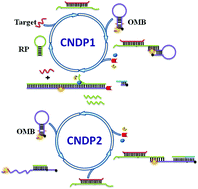Highly sensitive detection of cancer-related genes based on complete fluorescence restoration of a molecular beacon with a functional overhang†
Abstract
The accurate detection of cancer-related genes is of great significance for early diagnosis and targeted therapy of cancer. In this contribution, an automatically cycling operation of a functional overhang-containing molecular beacon (OMB)-based sensing system was proposed to perform amplification detection of the p53 gene. Contrary to the common molecular beacon (MB), a target DNA is designated to hybridize with a label-free recognition probe (RP) with a hairpin structure rather than OMB. In the presence of a target DNA of interest, the locked primer in RP opens and triggers the subsequent amplification procedures. The newly-developed OMB is not only capable of accomplishing cyclical nucleic acid strand-displacement polymerization (CNDP) with the help of polymerase and nicking endonuclease, but is also cleaved by restriction endonucleases, removing the quencher away from the fluorophore. Thus, the target DNA at an extremely low concentration is expected to generate a considerable amount of double-stranded and cleaved OMBs, and the quenched fluorescence is completely restored, leading to a dramatic increase in fluorescence intensity. Utilizing this sensing platform, the target gene can be detected down to 8.2 pM in a homogeneous way, and a linear response range of 0.01 to 150 nM could be obtained. More strikingly, the mutant genes can be easily distinguished from the wild-type ones. The proof-of-concept demonstrations reported herein are expected to promote the development of DNA biosensing systems, showing great potential in basic research and clinical diagnosis.


 Please wait while we load your content...
Please wait while we load your content...